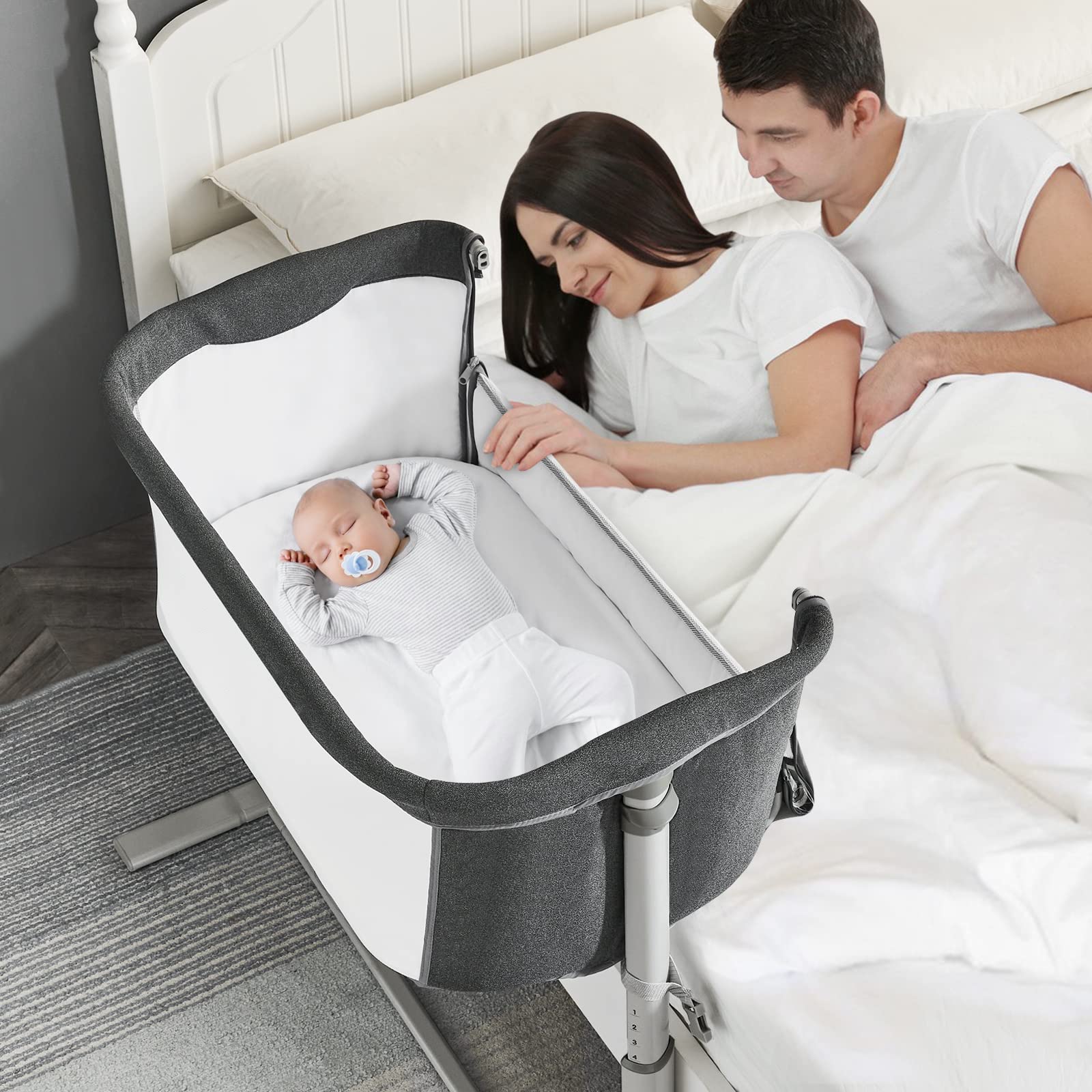A Joyful Journey Begins with the Perfect Bassinet: The Ultimate Guide for New Parents
Hello, lovely parents and parents-to-be! Are you embarking on the delightful journey of parenthood and seeking that perfect little nest known as a bassinet for your bundle of joy? Well, worry not, for here is your go-to guide packed with tips, safety advice, and key features to look for in a bassinet for newborns. We’re going to dive into the cozy world of bassinets and find the best snug spot for your little one to doze in dreamland!
Understanding the Basics: What is a Bassinet?
Before we venture forth, let’s understand exactly what a bassinet is. A bassinet is a small bed specifically designed for babies from birth to around 4-6 months of age. It’s the ultimate cozy corner for your infant, designed to keep baby close and snug during those early stages when they’re not yet mobile and need constant supervision.
Why Choose a Bassinet?
There are a plethora of reasons as to why a bassinet may be the best choice for your new arrival. They’re not just adorable, but also immeasurably practical for several reasons.
- Portability: Bassinets are generally lightweight and compact, making it easy to move them from room to room. This means your baby can always be by your side, whether you’re cooking dinner or catching up on some well-deserved rest.
- Coziness: The smaller space provides a womb-like environment that can help soothe and comfort a newborn. This cozy setup can make sleep transitions smoother for your little dreamer.
- Convenience: Easy access for nighttime feedings and comforting is a game-changer for tired parents. Plus, many models come with storage space underneath for keeping diapers and other necessities at arm’s reach.
Key Features to Look for in a Bassinet
With the vast array of options on the market, choosing the right bassinet can feel overwhelming. Here are some key features to consider that will help guide your purchase:
Safety Standards
The safety of your precious little one is paramount. Ensure the bassinet you select complies with current safety standards set by the Consumer Product Safety Commission (CPSC). It should have a sturdy frame, a firm mattress, and be free of any hazardous small parts or decorations that could pose a risk.
Comfort and Mattress Quality
Your baby will be spending a considerable amount of time nestled in their bassinet, so a good mattress is crucial. Look for one that is firm to reduce the risk of Sudden Infant Death Syndrome (SIDS) and ensure it fits snuggly without gaps.
Size and Weight Limits
Pay attention to the size and recommended weight limits of the bassinet. This not only ensures the safety of your baby but also helps you gauge how long you’ll be able to use it before transitioning to a crib or larger bed.
Bassinets are a fantastic option that can provide comfort, convenience, and peace of mind during your newborn’s first months. In the next section, we will take a deeper dive into types of bassinets, additional comfort features to consider, and ways to ensure the longevity of your chosen bassinet. Until then, imagine those sweet dreams your little one will have in their new, safe, and snug haven!

5 Essential Tips for Preparing for Your Newborn’s Bassinet
As you continue to navigate through the myriad of parenting decisions, preparing for your newborn’s bassinet is an important step to ensure their safety and your peace of mind. Consider these five essential tips as you prepare for the arrival of your precious one:
1. Space and Location
Decide where you will place the bassinet in your home. It should be in a quiet and temperature-controlled room to ensure optimal sleep conditions for your baby. Avoid placing it near windows or any drafty areas, and make sure it’s positioned away from cords, drapes, and other items that your little one could pull or tug on.
2. Assemble with Care
When your bassinet arrives, allocate time to carefully assemble it according to the manufacturer’s instructions. Double-check all connections and fastenings for stability—after all, this little bed will carry your most treasured possession. If you’re opting for a second-hand bassinet, inspect it thoroughly to confirm it’s in good condition and hasn’t been subject to any recalls.
3. Select the Right Bedding
Choose fitted sheets that are designed for your specific bassinet model to ensure they won’t come loose. The bassinet should not have any extra bedding, pillows, or stuffed animals as they pose suffocation risks. A simple fitted sheet over the firm mattress is all that’s needed for your baby’s comfort and safety.
4. Establish a Safe Sleep Environment
Embrace safe sleep practices by laying your baby on their back for sleep, following the American Academy of Pediatrics (AAP) guidelines. Keep the sleep area free of blankets, toys, and other soft items that could obstruct your baby’s breathing space.
5. Routine Checks and Maintenance
Consistently conduct checks on the bassinet to ensure its structural integrity remains intact. Test the mattress firmness regularly, look for loose screws, and confirm that the fabric is still securely attached. Proper maintenance will extend the lifespan of your bassinet and safeguard your baby’s sleep environment.
With these guidelines in mind, let’s delve into the various types of bassinets to help you identify which style will best suit your family’s needs. We’ll explore traditional bassinets, bedside sleepers, portable options, and more. Plus, we’ll highlight the importance of breathability, mobility features, and how to maximize the longevity of your chosen bassinet. So let’s continue our journey to find that dreamy slumber spot for your newborn!
Diving into Bassinet Varieties: Which Type Suits You Best?
Bassinets come in all shapes and sizes, with different functionalities to suit varied parenting styles and home setups. Here are some popular types of bassinets to consider:
- Classic Bassinets: These typically feature a stationary frame with a basket-like area for the baby to sleep. Many come with a canopy to shield the baby from bright lights.
- Bedside Sleepers: Designed to fit snugly against your bed, bedside sleepers allow for easy access to your baby during the night without the need to get out of bed, making them a great option for nursing mothers.
- Portable Bassinets: Ideal for families on the go, portable bassinets are lightweight with features like foldable frames and carrying handles. Some even have features like rocking bases to help lull your baby to sleep.
- Multi-Function Bassinets: These versatile options may serve as a bassinet, changing station, or play area as your baby grows, offering all-in-one convenience.
While assessing these types, keep in mind the room in which you plan to use the bassinet and your lifestyle. Do you travel often? Are you tight on space? Asking yourself these questions will help you narrow down the best choice for your family.
As you inch closer to making a decision, remember that comfort should go hand-in-hand with functionality and safety. Keep an eye out for additional features such as breathable mesh sides, which promote good air circulation, or vibration settings that can help soothe a fussy baby back to sleep.
Ensuring the longevity of your bassinet is also straightforward. Opt for models with removable and machine-washable covers to maintain hygiene and consider those with adjustable height settings that can grow with your baby, although always within the weight limit guidelines.
Choosing the right bassinet is just the beginning. Soon, you’ll be embarking on countless adventures and making unforgettable memories with your newest family member. Take your time to select a bassinet that promises safety, serenity, and sweet dreams for your precious little one.
For more great articles please see here. For more information see here
Disclaimer
The articles available via our website provide general information only and we strongly urge readers to exercise caution and conduct their own thorough research and fact-checking. The information presented should not be taken as absolute truth, and, to the maximum extent permitted by law, we will not be held liable for any inaccuracies or errors in the content. It is essential for individuals to independently verify and validate the information before making any decisions or taking any actions based on the articles.




